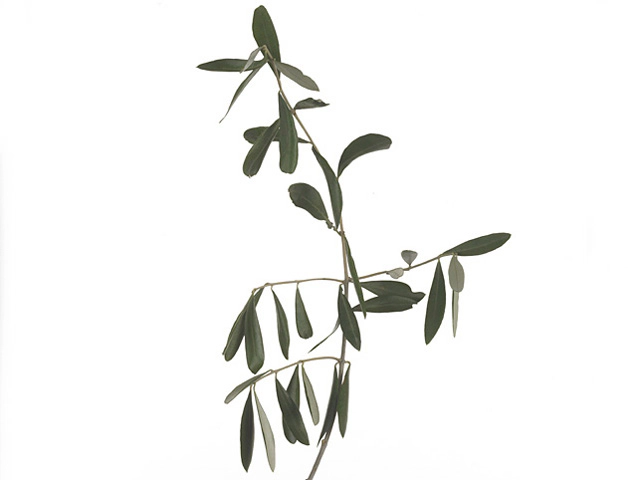Olea europaea

| Leaf arrangement | crosswise opposite |
| Leaf tip | Mucronate |
| Leaf margin | Entire |
| Leaf, general shape | Lanceolate |
| Leaf surface | Smooth; Dull |
| Leaf size | 5 - 7,5 cm |
| Leaf, main color | Dark green |
| Leaf colour, pattern | Unicolored |
Olea europaea, commonly known as the olive tree, is a perennial evergreen tree that is native to the Mediterranean region. It is widely cultivated for its fruit, which is harvested for its oil and often used in cooking and cosmetics. However, the tree itself also possesses several noteworthy characteristics, particularly when it comes to its leaves.
The arrangement of the Olea europaea's leaves is crosswise opposite, meaning that they are situated directly across from each other on the stem. This arrangement creates an aesthetically pleasing pattern and adds a sense of symmetry to the tree's overall appearance.
The leaves of the olive tree are lanceolate in shape, meaning that they are elongated and narrow with pointed tips. This gives them a slender and elegant look, enhancing the tree's overall beauty.
One notable feature of the olive tree's leaves is their mucronate tips. The term "mucronate" refers to a small, sharp point at the apex of the leaf. This unique characteristic adds a delicate touch to the overall appearance of the leaves.
The leaf margins of the Olea europaea are entire, which means they are smooth and continuous without any serrations or indentations. This smooth margin further adds to the refined and streamlined appearance of the olive tree's leaves.
The surface of the leaves is smooth and dull, providing a matte finish. This feature gives the leaves a subtle texture and contributes to their overall appearance of calmness and tranquility.
In terms of size, the leaves of the olive tree typically measure between 5 to 7.5 centimeters in length. This moderate size allows the leaves to create a dense foliage that provides shade and shelter to the tree and its surroundings.
The dark green color of the olive tree's leaves is a distinguishing characteristic. It gives the tree a sense of vitality and lushness, enhancing its natural beauty. The unicolored pattern means that the leaves do not display any distinct patterns or variegations. This simplicity adds to the tree's elegance and makes it a perfect fit for various landscapes and gardens.
In conclusion, the Olea europaea, or olive tree, is renowned for its distinctive leaf characteristics. Its crosswise opposite leaf arrangement, lanceolate shape, mucronate leaf tips, entire leaf margins, smooth and dull leaf surface, moderate size, dark green color, and unicolored pattern all contribute to its overall aesthetic appeal. Whether grown for its fruit or simply for its visual beauty, the olive tree is a captivating addition to any environment.
Market availability index by month:
| Jan. | Feb. | Mar. | Apr. | May | Jun. | Jul. | Aug. | Sep. | Oct. | Nov. | Dec. |
|---|---|---|---|---|---|---|---|---|---|---|---|
| 3 | 3 | 3 | 3 | 4 | 3 | 3 | 3 | 3 | 4 | 4 | 4 |